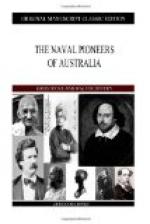The scientific results of the Roebuck’s voyage were, chiefly on these accounts, of no great importance, judged by the standard of such work to-day; but, with the state of nautical science at the time, not much was to be expected in the way of accurate surveying.
When Dampier set out to explore the coast of New Holland, what charts, what instruments, what scientific knowledge and equipment, had he for the work?
Dampier’s time was distinctively an intermediate period. Little more than a century had elapsed since Gerard Mercator’s chart was published, and Edward Wright had taught its true principles, and about half a century before the voyage of the Roebuck such improvements as Gunter’s application of logarithms to nautical calculations, middle latitude sailing, and the measurement of a degree on the meridian were introduced. Hadley’s quadrant came thirty years after Dampier, who must have used Davis’ instrument, then about ninety years old. Davis’ work on navigation, with Wright’s chart showing the northern extremity of Australia, and Addison’s Arithmetical Navigation (1625) were, no doubt, text-books on board the Roebuck. Longitude by chronometer was to come half a century after Dampier was in his grave, and such charts as he possessed did little more than indicate the existence of Terra Australis. The Portuguese, Spanish, and Dutch maps were not easy for Englishmen to procure, and all that Dampier has to say on the matter is:—
“But in the draught that I had of this coast, which was Tasman’s, it was laid down in 19 degrees, and the shore is laid down as joining in one body or continent, with some openings appearing like rivers, and not like islands, as really they are.... This place, therefore, lies more northerly by 40 minutes than is laid down in Mr. Tasman’s draught, and besides its being made a firm, continued land, only with some openings like the mouths of rivers, I found the soundings also different from what the line of his course shows them, and generally shallower than he makes them, which inclines me to think that he came not so near the shore as his line shows, and so had deeper soundings, and could not so well distinguish the islands. His meridian or difference of longitude from Sharks’ Bay agrees well enough with my account, which is 232 leagues, though we differ in latitude. And, to confirm my conjecture that the line of his course is made too near the shore, at least not so far to the east of this place, the water is there so shallow that he could not come there so nigh.”
That the narrative of Tasman’s voyage was at [Sidenote: 1638-1697] that time in existence there is little doubt, and an outline of the coasts visited by him was given in an atlas presented to Charles II. of England, in 1660, by Klencke, of Amsterdam, and now in the British Museum. Major also found in the British Museum copies of charts and a quantity of MS. describing Tasman’s 1644 voyage, which,




